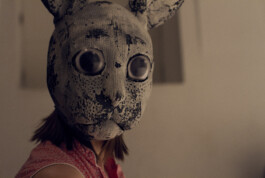
MIRJAM & MYRIAM oder Sieh Dich vor
Eine Koproduktion von DSCHUNGEL Wien & Theater Koblenz Uraufführung: 12.1.2016 am DSCHUNGEL Wien
Text / Regie: Katharina Kummer
Darstellerinnen: Myriam Rossbach, Mirjam Schollmeyer
Musik: Karl Philipp Kummer
Bühne: Katharina Kummer, Jessyca R. Hauser
Kostüme: Sabrina Krämer
Masken: Hagen Tilp
Kinderstimme: Lotte Heinrich-Frank
Photos: Ani Antonova
MYTH OF THE FUTURE or: We end up thinking with our ass.
A conversation with Katharina Kummer about her work on "MIRJAM & MYRIAM or: Beware of being trapped in a little girl's dream.
What was your starting point?
The point from which I have begun to think is a reflection by the Viennese philosopher Elisabeth von Samsonow. She analyses the figure of the girl as a lost symbolic position which, because it has been forgotten by history, holds revolutionary potential. This thesis, inturn, holds great theatrical potential for me. It evokes ideas of a mythical future in which girls have subverted the system of order.
They can play, no one ever really takes them seriously. Instead of seeing this as a weakness, I look for the possibilities that arise fromit. Untaken and forgotten, the girl doesn't have to break down restrictions first, because there are none!
This makes it free and dangerous to order.
And this potential is accessible to everyone, because being a girl is not a biological fact in this consideration, but a position that can betaken by all. A "way of being in the world". Elisabeth von Samsonow says she knows many boys who are already girls. I canonly underline that! Even my father has come out of the closet by now.

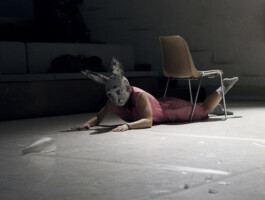
You call your piece a stage essay....
As an author, I write the play into the stage, so to speak. My aim is to use the theatre as a scene for excessive shared thinking. The specific possibility of theatre is that we can do full-contact philosophy here - that is, that the thoughts of our "essay" can be experienced on so many levels: intellectually, affectively, physically. Together, in direct contact with all participants, I want to explore our notions of reality and
push their limits into a yet unknown space of experience. With "MIRJAM & MYRIAM or: Beware of being trapped in a little girl's dream" I wanted to create a myth of the future.
Underneath the text lies the structuring sequence of a (Latin American) initiation ritual for 15-year-old girls. I have used the chronology of this ritual to open up the web of motifs and thoughts that I have spun out of the wealth of material. It is the structure of thisinitiation feast that we follow affectively, from the arrival of the gueststo various dances and meals to ceremonial acts. None of this can be explicitly seen, but it has inspired a certain rigour in our work and can be felt - as the pulse of the time we spend together.
Myth of the future - what do you mean by that?
For example: We imagine ourselves in a future where a swarm of girls has subverted order. This imagination that we project into the future also conjures up mythical narratives of the past: Persephone, the "unspeakable girl" from the Greek mystery plays,has to go to the underworld. We refer to existing rituals and concepts, perform a kind of exorcism of the canonical knowledge that is in us and lives on, and then try to break through the texture of reality in the "ritual" that we design for the evening, towards an inkling and opening of new spaces of experience and concepts.
How does that look on the stage then?
The piece follows less of a chronological plot than musical laws. It unravels a web of motifs. The motif of the dream runs through it, others are the totem animal, the zombie motif, the trans motif - "trans" in the sense of transgression in various respects, or the motif of phantasm, ambiguity, and confusion, which already appears in the title: Mirjam & Myriam. Who is caught in whose dream? We flirt with reality - but miss the mark. The two players are really called Mirjam and Myriam. But even though the way they play seems close to their characters and their way of speaking often comes across as commonplace, each move is precisely choreographed, and even when they address each other by their real names, the characters in the play reveal nothing at all about the actresses during their chit chat.
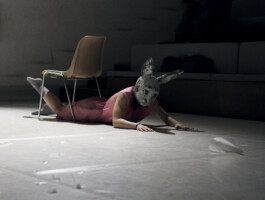
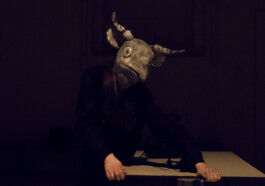
So you want to open up a new space of experience for the term girl?
Yes. We crawl into the furthest catacombs of the term, imbibe it, let it slip through us and release it again. We end up thinking with our asses. Our central means also has to do with this: edible paper. Everything that the players negotiate emerges from it and passes away. There are no props. Everything is "non-existent". Except for the printed A-4 dining paper. Whatwe negotiate on it is eaten - also by the audience. We end up sharing thoughts and experiences, digesting them, and so on.
So you want to open up a new space of experience for the term girl?
Yes. We crawl into the furthest catacombs of the term, imbibe it, let it slip through us and release it again. We end up thinking with our asses. Our central means also has to do with this: edible paper. Everything that the players negotiate emerges from it and passes away. There are no props. Everything is "non-existent". Except for the printed A-4 dining paper. Whatwe negotiate on it is eaten - also by the audience. We end up sharing thoughts and experiences, digesting them, and so on.
How would you describe your working practice?
As I said, as Écriture on the stage. Researching together and being ignited by thinking. We rehearsed over an unusually long period of time. In intervals. The players were thus able to findtheir way into the labyrinth into which I led them. The work could boil down like a good goulash.You can see this long and precise joint examination in the completely unpretentious seriousness with which the two players make the evening experienceable.
I have often worked with this musician. He immediately recognises the affective direction I wantto take behind the abstract and complex text and then translates it into music for the others. He throws out the ground on which the players can dance, invent, and try out.
You always name a lot of people whose texts and reflections have been incorporatedinto your stage essay. Which ones are particularly important in the piece?
Besides the aforementioned Elisabeth von Samsonow, my "favourite philosopher" Marcus Steinweg, Marguerite Duras, Agamben's writing "The Unspeakable Girl" about the ancientmystery plays - and of course the many interview partners!

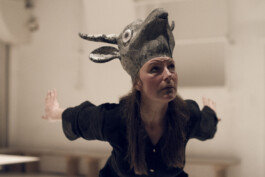
How did the text come about in concrete terms?
First, I drafted a score from texts and quotations. Partly formulated scenes, partly just descriptions of how I imagine the essence of whatis happening. This outline served to give the team an idea of where we might end up. During the half a year we were able to work together, I gradually replaced dummy texts from the first version withmy own, condensed from interviews or research, which I had tested on the players or discussed with the team.
Unlike my mother piece, for which I recorded countless oral conversations, mostly at people's homes on tape, here I opted for chat interviews. This has shaped the text. The incorporeal, floating, shadowy quality that characterises the term "girl" becomes traceable through the chat's incorporeal mode of communication. The interconne§
An example?
In the piece, for example, there is not a single instance of an attribution linked to gender other than "girl". In this way, I have also freed "girl" from its gender link. There is only "girl" in our cosmos. Everything else would then simply be a non-girl. If we were to break this even once, we had to position ourselves in the whole gender-political field and found ourselves - poof - in an Atmosphere of activism. But we want a myth of the future. And this too - the edible paper will take its path – shall again be overcome by others.
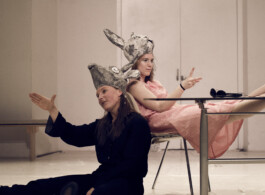
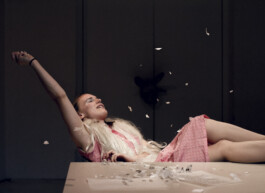
What does all this have to do with puppet theatre?
All that. The whole way of working is puppet-theatrical. A puppeteer who was in the piece as an audience member made a remark that pleased me enormously: "Girls will ... will ... will become an object herself". That hits a point that is important to me. I use every theatrical device as if it were a puppet. In the sense that I allow it to have a life of its own. The light has to become a player. The music is an autonomous player. Language is a player. These elements are personified. They behave. And of course they do not live by themselves, but are "animated", just like a puppet. The light, for example, is animated by me as the director, who is herself a puppeteer. Then later by the lighting technician. The music by the musician. The edible paper intervenes in the stage action again and again. There is even a scene with puppets (made of edible paper) in a more classical sense. It moves on the edge of the grotesque and is a perfectly crafted puppet show.
If you could think of one thing to communicate to people with the piece, what would it be?
Initiation rituals introduced people to the sexual world. All societies knowsuch rituals and they naturally say a lot about how a society imagines this world. I wondered what such an initiation would look like if I could decide about it. It would be a celebration of ambiguity.
But in this case, I have decided to initiate everyone to be girls. I want everyone to want to be girls in the end!